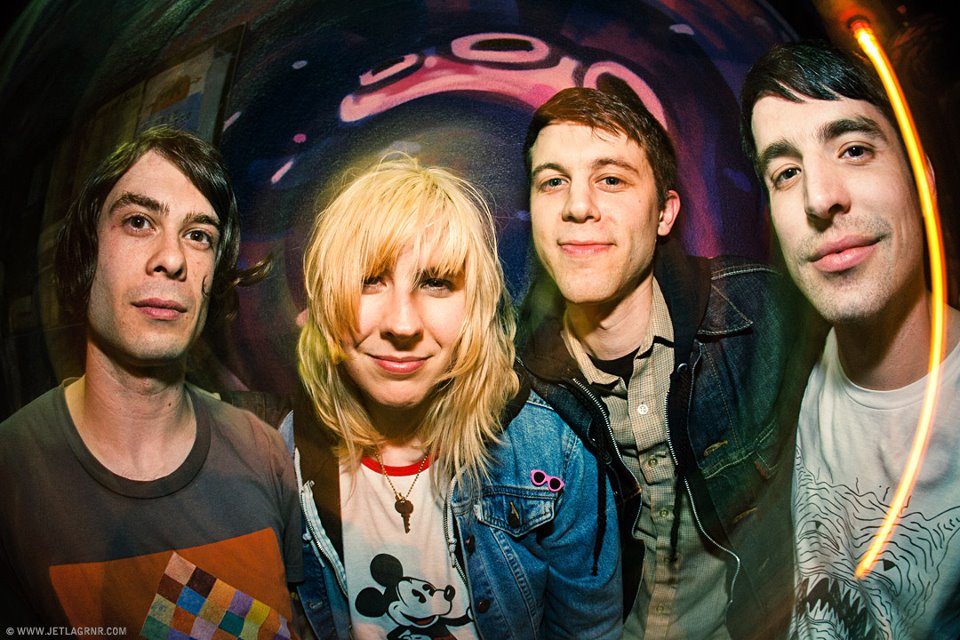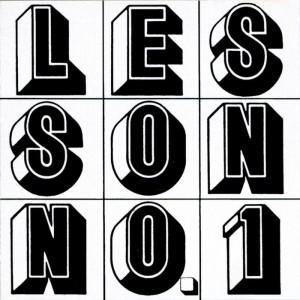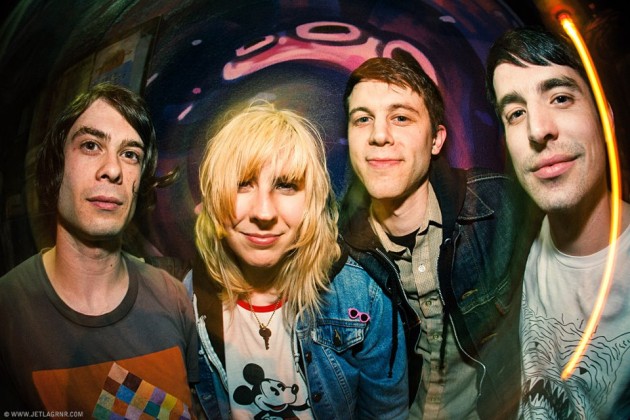
Rob Garcia and Sarah Everton started producing sparse, minimalist noise pop as Reading Rainbow in 2008 — now, five years, one syllable change, and two new members later, the four-piece band is on the cusp of putting out their third full-length record, the most ambitious and expansive of their career. In a special installment of On Deck, we asked the band to pick the five records that most influenced their new album’s sound before talking to guitarist and founding member Rob Garcia about the benefits of self-taught guitar playing, finding the sweet spot between pop and noise, and Bleeding Rainbow’s new LP, Yeah Right, out tomorrow on Kanine Records.
Guitars Guitars Guitars Guitars! While we were on a long 6 week national tour back in March of 2011, we hadn’t started writing songs yet for what would become Yeah Right, but ideas and sounds started forming in our heads around this time period. We became more and more obsessed with aggressive, dissonant, and moody guitars. Our top 5 influential albums reflect our need for speed.
From the amazing instrumental sections of “No Fair” to the incredible one-two punch of “Taking Too Long” and “Can this Be?” this album sparked a little fire inside of us. We became obsessed. We began to revisit guitar-heavy albums and found new inspiration.
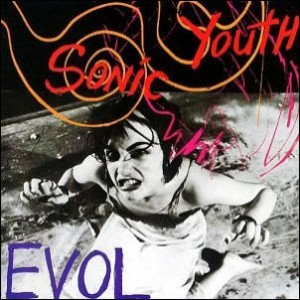
Sonic Youth – Evol
Speaking of moody guitars. I can still remember listening to this album for the first time and having my mind completely blown. Everyone in our band agrees that this is one of Sonic Youth’s best records. Come from a time period where they were still very experimental, but beginning to become better song writers. This album (pretty much all Sonic Youth albums) proves you don’t have to be an Eddie Van Halen shred-master to be able to play the guitar.
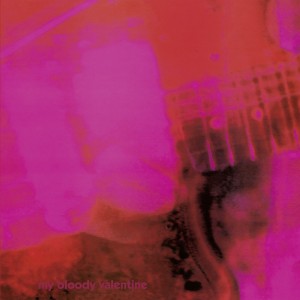
My Bloody Valentine – Loveless
This album is basically a template for how to make a guitar not sound like a guitar. There are a lot of imitators, but only one original. Became the definition of “shoegaze.” Atmosphere goes a very long way, but if you don’t have hooks, the music is not enjoyable. More shoegaze bands need to understand this.
Our reaction to “Lesson No. 1 for Electric Guitar”: HOLY SHIT!!!!!!!! Minds completely blown. Did not know music like this was possible. This album was a huge source of inspiration. Simultaneously gorgeous and disgusting. So complex, yet easy to understand. We’ve done many long drives with this album blasting at full volume.

Smashing Pumpkins – Siamese Dream
Back to the Pop. We can’t help it. It had been a very long time since listening to this album. Especially for Sarah, who was a Smashing Pumpkins super fan when she was 14, revisiting this album was a very nostalgic experience. We were reminded that music is not only an outlet for angst and aggression, but also an escape to another world where anything is possible.
BeatsPerMinute (Ryan Stanley): It’s interesting that your list is so guitar-focused, because one of the things I consistently noticed about each of the singles from Yeah Right was how thick and distinctive the guitar sounds and tones were. Was that something that you guys specifically focused on during the recording of the new record? Was there any one specific change in the recording process that really affected the way your guitars ended up sounding?
Rob Garcia: Absolutely! Guitar tones and sounds were a huge focus for us when we went into the studio to record this album. We wanted the songs to have a thick and aggressive sound, but simultaneously match whatever aesthetic we were going for on each particular song. The most major change in the recording process this time around was that we actually recorded in legit studios and worked with producers who understood what we wanted and how to achieve it. Kyle “Slick” Johnson was huge in shaping the atmosphere of the songs.
BPM: How’d you guys get set up with Johnson? Was that done through your label or were you fans of his previous work?
RG: Al Creedon in our band actually works as an assistant to Kyle. So in addition to being familiar with his previous work, we knew that his methods of recording and producing matched very well with our goals for the album. Also, we essentially recorded the album twice. It was a long drawn out process and both studios we went to were helpful in different ways. But as I mentioned before, Kyle really understood what we were trying to go for and was able to push the aesthetic of each song further.
BPM: Having produced this record in a studio and with a full band, how do you guys feel about it in comparison with your previous work?
RG: In the context of our previous albums, Yeah Right is us as a band growing and pushing ourselves to make music that is more challenging/rewarding/fun for us to make. We all agree that it was a huge step forward and one that we were all ready to make. If people that liked us before cant wrap their head around it, then too bad for them. We’re still gonna be pushing ourselves forward.
It’s still possible to be loud and intense but not be super macho.
BPM: What’s the story behind the album title Yeah Right?
RG: There’s a lot of ways the phrase “yeah right” can be used. It can be said in disbelief or can also be confrontational. We were pretty sure that people familiar with our band would not expect us to be able to write these types of songs. We kept getting the feeling that everyone was labeling us as something we weren’t. So this album was a reaction to that feeling. And there’s also a 90’s slacker vibe to the phrase, which we like as well.
BPM: Bleeding Rainbow’s music often brings to mind the sounds of the kind of 80s and 90s indie rock bands that you mentioned in your On Deck list. Do you consider yourselves revivalists?
RG: We don’t really consider ourselves revivalists. There was no band meeting where we unanimously decided we were going to emulate the sounds of specific bands. I feel like with most music its pretty easy to tell who’s an influence; but with that said, we also miss hearing new music that has really aggressive guitars, while still having emotional depth and maintaining certain aspects of pop. It’s still possible to be loud and intense but not be super macho. I feel like a lot of our favorite bands from the 80’s and 90’s had this great type of balance.
BPM: Who’s designed Bleeding/Reading Rainbow’s album art in the past? A lot of it has a very consistent style.
RG: Sarah has designed all of the album artwork for everything we’ve released except for one 7″ we did a while ago. This is really important to us because it keeps our band’s aesthetic consistent. Since Sarah is in the band, there’s also a real connection between the music we are making and the visual art that accompanies it. Even though this connection may be subconscious, we all believe it helps get the vibe across.
BPM: Bleeding Rainbow has always seemed to be inclined towards both the world of drone and noise and the world of pop songs. Which of those two sounds comes most naturally to you?
RG: Especially when writing songs for this album, the noise and drone came first. A lot of the dissonant guitar riffs on this album were made up by Sarah. I would hear her in the basement teaching herself how to play guitar and then all of the sudden hear something really amazing and run downstairs and yell “WHAT ARE YOU PLAYING?” Then we would take those ideas to the band and formulate the rest of the song. The pop element comes in because we still wanted the songs to be accessible and to have hooks.
Our goal was to create an album that could transport you to another world.
BPM: This is the first album on which Sarah has played guitar, correct?
RG: Yes, this was the first album Sarah played guitar on. Since she is self taught, her approach to playing guitar is completely different than mine. This turned out to be a really great source of inspiration for our songwriting.
BPM: Did your recent lineup change affect the songwriting on Yeah Right in any other unexpected ways?
RG: I guess another aspect of the songwriting that was different than previous albums was that we focused a lot on song structures. Previously, it would almost be stream of conscious. But now as a full band, we could jam out the different parts and feel our way through the songs. We wanted the songs to be expansive and to find different pathways through each segment. We really wanted to have segues and orchestrated instrumental sections. This was not possible at all as a 2 piece.
BPM: So would you guys define yourselves more as a noisy pop band or as a poppy noise band?
RG: We see ourselves as a poppy noise band. That’s what we are striving for anyway. We’ve already been demoing new songs and they’re getting really intense.
BPM: What’s the bigger motivation for being in a band like Bleeding Rainbow: making records or putting on shows?
RG: It’s hard to be specific, because they’re both so different. For Yeah Right, our goal was to create an album that could (as cheesy as it sounds) transport you to another world. Something that would enable you to have an out of body experience. When we perform live, we know that we are never gonna sound exactly like the album, and frankly don’t want to. Our live show is essentially our album boiled down to the essence of what that sound is: raw, aggressive, emotional….
BPM: You guys do tend to have a pretty loud and intense live show — do you ever worry about damaging your ears when you’re on the road for weeks at a time?
RG: Let them bleed.
Yeah Right is out tomorrow, January 29th, on Kanine Records. Listen to Bleeding Rainbow’s previous material over at the band’s Bandcamp and stream Yeah Right now over at Pitchfork.

